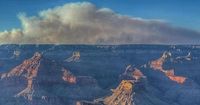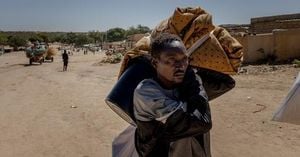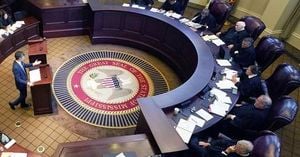On the Fourth of July, 2025, a bolt of lightning struck the dense pine forests of the Grand Canyon’s North Rim, igniting what would become one of the most consequential wildfires in Arizona’s recent history. Dubbed the Dragon Bravo Fire, this blaze would go on to consume nearly 145,000 acres, destroy a century-old lodge, and force the indefinite closure of one of America’s most iconic natural landmarks. Two months later, as the last embers smolder and the smoke clears, questions about the response and management of the fire linger, leaving local businesses, residents, and elected officials searching for answers.
The North Rim, perched at 8,000 feet above sea level, is a world apart from the bustling South Rim that draws the lion’s share of the Grand Canyon’s five million annual visitors. Here, the landscape is a patchwork of broad plateaus and thick pine forests, with businesses few and far between. Among them is the Jacob Lake Inn, a fourth-generation family business that has served as a beacon for travelers for over a century. Known for its fresh cookies and warm hospitality, the inn is a vital hub for the region’s modest tourism economy.
But the summer of 2025 brought an abrupt halt to the inn’s familiar rhythms. As the Dragon Bravo Fire advanced, employees, guests, and residents were forced to evacuate with little warning. Melinda Rich Marshall, the inn’s current operator and great-granddaughter of its founders, reflected on the impact. "In my lifetime, I can think of, like, six that have created economic problems for our family and for Jacob Lake," she told NPR. The financial hit was immediate and severe: with the North Rim closed indefinitely, Rich Marshall had to refund about $350,000 in reservations. "We don't even know how to imagine what the winter's going to be like because we don't know how we're going to actually make it through financially," she admitted. "Right now, we're just really trying to be creative just like our ancestors were."
The Jacob Lake Inn was not alone in its struggles. Scores of local businesses across northern Arizona’s national park gateway communities felt the pinch after a particularly brutal wildfire season. According to NPR, more than 200,000 acres burned on the north side of the Grand Canyon in July and August alone. The closure of the North Rim not only disrupted the summer tourist season but cast a long shadow over the prospects for recovery in the fall and winter.
Yet, amid the economic devastation, there emerged a surprising assessment of the fire’s ecological impact. When the Burned Area Emergency Response (BAER) Team—comprising soil specialists, botanists, wildlife biologists, and other federal experts—arrived to survey the damage, they braced for the worst. "When we came into this, we were expecting to look at devastation," said TJ Clifford, the team’s leader. "So, I was more buoyant as soon as I flew over it and said, 'Okay, we can do this.'" Their analysis revealed that nearly three-quarters of the area inside the Dragon Bravo Fire’s perimeter either did not burn or burned at a low severity. While some stretches resembled a moonscape, with charred vegetation and thick ash, most of the area was expected to recover quickly.
Clifford’s verdict was cautiously optimistic: "My overall opinion is this was a good tool for forest health. It's providing the diversity that we need out there. It's also showing that past fuels treatments and past wildfire did a good thing for preventing that devastating impact." According to NPR, fire managers in the West often allow lightning-caused wildfires to burn under controlled conditions to promote forest health—a practice that was initially adopted with the Dragon Bravo Fire. The National Park Service, in public statements and on social media, described its early approach as a "confine and contain strategy."
However, nature had other plans. A week after the fire began, historically dry and windy conditions fueled a dramatic expansion of the blaze. The consequences were catastrophic: the fire destroyed the Grand Canyon Lodge, a beloved structure perched on the North Rim for over 100 years, along with employee housing and more than 100 park structures. The North Rim was shut down indefinitely, and the cost of fighting the fire soared to nearly $130 million.
The scale of the destruction—and the shifts in firefighting strategy—sparked outrage and demands for accountability from Arizona’s elected officials. Democratic Senator Ruben Gallego voiced his frustration: "At this point, we have not received any information or any response that makes us think that they're even really fully grasping what occurred and how it occurred." In July, Gallego and fellow Democratic Senator Mark Kelly wrote to Secretary of the Interior Doug Burgum, seeking answers about the management of the fire. Republican Representative Paul Gosar also requested more information, while Democratic Governor Katie Hobbs called for an independent investigation. "The administration and the National Park Service really needs to answer what happened so we could potentially stop this from happening in the future," Gallego insisted.
Since the destruction of the lodge, the National Park Service has maintained that it intended to fully suppress the Dragon Bravo Fire from the start. Even now, as the fire is nearly extinguished, managers have yet to declare it fully contained. Meanwhile, the Park Service has largely declined to speak publicly about the incident. In an emailed statement, Grand Canyon National Park Public Affairs Officer Joëlle Baird explained, "An interagency review team will be delegated the task to provide a comprehensive evaluation of the fire's management and operational response. These national-level reviews are thorough and can take months to complete."
For the communities surrounding the North Rim, the wait for answers is more than a matter of curiosity—it’s a question of survival. Many, like Rich Marshall, are urging officials to reopen at least some North Rim viewpoints to bring back the tourists who sustain their livelihoods. The economic aftershocks of the fire are likely to reverberate through the winter and beyond, with the fate of businesses, jobs, and even local traditions hanging in the balance.
Yet, as the charred forests begin to show signs of renewal and the first green shoots return, there is also a sense of resilience. The Dragon Bravo Fire has underscored both the risks and the necessity of adaptive management in an era of hotter, drier summers and increasingly volatile wildfire seasons. As the interagency review unfolds, the lessons learned from this summer’s disaster will shape not just the future of the Grand Canyon’s North Rim, but the broader approach to wildfire management across the American West.
For now, the story of the Dragon Bravo Fire remains unfinished—a cautionary tale of nature’s power, human decisions, and the enduring hope for recovery in the face of adversity.




